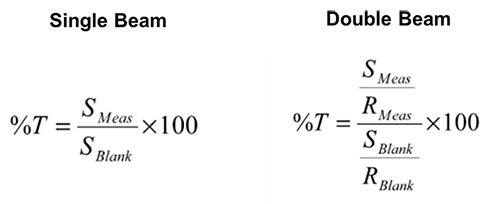How do spectrophotometers use the blank?

Single-Beam Spectrophotometers
Single-beam spectrophotometers perform blank correction and sample measurements using only the sample beam. First the instrument records the intensity of the sample beam during blank correction (SBlank). Then, during sample measurement, the instrument records the intensity of the sample beam (SMeas). Measurement results are then calculated using SBlank and SMeas. For example, transmittance (%T) is calculated using the following formula. However, if the intensity of the light source varies between the blank correction and sample measurement, it can appear as variations in SBlank and SMeas values. In other words, if the light source intensity varies between the time the blank correction and sample measurement are performed, inaccurate data may be acquired. Thus, in single-beam systems, fluctuations in the light source intensity can have a major effect on measurement results. Therefore, single-beam systems require waiting until the system stabilizes before starting measurements. As a general rule, they require waiting about one to two hours after switching the power ON.
Double-Beam Spectrophotometers
Double-beam spectrophotometers perform blank correction and measure samples using both sample and reference beams. During blank correction, the instrument records the SBlank/RBlank ratio, based on the sample beam intensity (SBlank) and the reference beam intensity (RBlank). Next, during sample measurement, the instrument records the SMeas/RMeas ratio, based on the sample beam intensity (SMeas) and the reference beam intensity (RMeas). Measurement results are then calculated using SBlank/RBlank and SMeas/RMeas. Unlike single-beam systems, double-beam systems determine measurement values using the ratio of sample beam intensity to reference beam intensity during both sample measurement blank correction. As shown, fluctuations in the light intensity do not affect measurement results. Essentially, using the ratio of sample and reference beam intensities in double-beam systems cancels out any fluctuations in the intensity of the light source and reduces the potential of such fluctuations affecting measurement values.
To summarize, data is not affected by light source fluctuations because the reference beam continuously compensates for any fluctuations in the intensity of the light source in real time. In other words, double-beam spectrophotometers accurately measure samples over long time periods by cancelling out lamp variations via ratio of the sample and reference beams. This means double-beam systems offer superior time stability.


